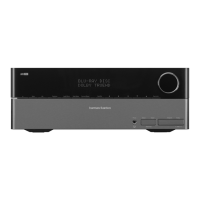
Do you have a question about the Harman AVR 2600 and is the answer not in the manual?
| Type | AV Receiver |
|---|---|
| Audio Channels | 7.1 |
| Number of channels | 7 |
| Power Output per Channel | 65W |
| Total Harmonic Distortion (THD) | 0.07% |
| Frequency Response | 10 Hz - 100 kHz |
| HDMI Inputs | 4 |
| HDMI Outputs | 1 |
| Dolby Digital | Yes |
| DTS | Yes |
| Bluetooth | No |
| Wi-Fi | No |
| Dimensions | 440 x 165 x 382 mm |
| Outputs | 1 HDMI |
| Inputs | 4 HDMI |
| Supported Audio Formats | Dolby Digital, DTS |
Essential safety guidelines and warnings for proper and safe operation of the apparatus.
Warnings for wet locations, service, outdoor use, and electrical shock.
Instructions for voltage verification, cord handling, cabinet access, and cleaning.
Guidelines for installation location, moving the unit, and user information.
Overview of the AVR 2600's features and Harman Kardon's audio heritage.
Details on audio amplification, processing, and supported surround sound formats.
Description of analog, digital, and video input/output terminals.
Features for user-friendly operation and list of supplied accessories.
Front panel power indicator, message display, volume knob, and IR sensor.
Buttons for accessing menus, selecting modes, and adjusting settings.
Buttons for menu navigation, source selection, and input jacks.
AC power socket, AM/FM antenna terminals, and accessory connections.
Analog and digital audio input/output jacks for various sources.
Composite, component, and HDMI video connections.
Terminals for speakers, SIRIUS tuner, IR control, and USB port.
Buttons for controlling the AVR and selecting input sources.
Buttons for adjusting audio, video, surround modes, and setup.
Buttons for menu navigation, volume adjustment, and muting.
Controls for playback, sleep settings, activities, and menu exit.
Components and setup of a standard home theater system.
Explanation of surround sound principles and individual speaker functions.
Function and optimal placement of the subwoofer for low-frequency audio.
Overview of different surround sound processing technologies.
Connecting the subwoofer and loudspeakers to the AVR terminals.
Introduction to connecting various audio/video sources to the AVR.
Explanation of analog, digital, and HDMI audio connection methods.
Details on composite, component, and HDMI video connections.
Positioning front left, right, and center speakers for optimal sound.
Recommended placement for surround speakers in a 5.1 system.
Recommended placement for surround and surround back speakers.
Tips for optimal placement of the subwoofer for best bass response.
Steps for designing your system's audio and video connections.
Determining best video and audio connection types for sources.
Matching devices to AVR input sources and assigning connections.
Performing initial physical connections for sources, display, and audio output.
Connecting FM antenna and optional iPod/iPhone dock.
Connecting AM antenna, SIRIUS tuner, and IR control devices.
Configuring the system for audio distribution to a remote zone.
Connecting power cords and installing remote control batteries.
Programming the remote to control various source devices.
Steps for turning on the AVR 2600 for the first time.
Utilizing the graphical interface for system configuration.
Automated speaker setup and room equalization process.
Selecting speaker layout and performing automatic calibration.
Setting up inputs, audio/video formats, and modes for each source.
Procedures for powering the receiver on and off.
Adjusting volume and using Dolby Volume processing for enhanced audio.
Adjusting Dolby Volume calibration based on speaker sensitivity.
Basic operational controls for muting, sleep timer, and headphone use.
Fine-tuning audio effects and video modes for optimal performance.
Selecting input sources and using the built-in radio tuner.
Resolving video display issues and optimizing HDMI connections.
Connecting and operating the SIRIUS satellite radio tuner.
Playing audio/video content from iPod/iPhone via The Bridge III.
Important considerations for viewing photos and videos from iPod/iPhone.
Entering manual mode for viewing photos stored on iPod/iPhone.
Choosing and adjusting surround sound modes for different audio sources.
Explanation of analog/digital audio signals and surround sound processing.
Guidelines for choosing surround modes based on source and preference.
Adjusting Dolby Pro Logic II/IIx music mode specific settings.
Manually configuring speaker settings if EzSet/EQ is not used.
Introduction to manual speaker configuration steps.
Determining speaker crossover, measuring distances, and setting number of speakers.
Setting specific crossover frequencies for speakers and subwoofer.
Configuring subwoofer mode and adjusting speaker delay settings.
Manually adjusting speaker output levels for balanced sound.
Detailed explanation of tone controls, LFE trim, and MP3 enhancer.
Introduction to video processing and picture adjustment options.
Adjusting picture settings like brightness, contrast, color, and aspect ratio.
Accessing noise reduction, color suppressor, and deinterlacing settings.
Guide to calibrating picture settings using test patterns for optimal display.
Operating the multizone system and configuring general system settings.
Adjusting video modes, custom picture settings, and convergence.
Configuring system settings and advanced remote control features.
Details on punch-through programming and creating activities (macros).
Programming activities and resetting the remote control.
Resetting the AVR and understanding setting memory retention.
Resolving problems with power, sound output, and video display.
Troubleshooting remote response, tuner buzzing, and SIRIUS problems.
Addressing issues with surround back settings, test tones, and program mode.
Detailed power, sensitivity, and frequency response specifications for audio.
Video processing capabilities, dimensions, power requirements, and weight.
Performance specifications for the AM and FM tuner sections.
